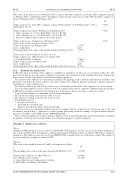Page 623 - SAIT Compendium 2016 Volume2
P. 623
IN 72 Income Tax acT: InTeRPReTaTIon noTes IN 72
The value of the private use for February 2013 is equal to the value of private use for the 2009 company car from 1 February 2013 to 14 February 2013 + the highest calculated value of private use of the 2009 and 2013 company car
from 15 February 2013 to 29 February 2013.
Value of private use of the 2009 company car from 1 February2013 to 14 February 2013 (3,5% × R200 000 × 14 / 28)
R 3 500
5 250
8 750
Value of private use from 15 February to 28 February 2013: • 2009 company car = 3,5% × R200 000 × 14 / 28 = R3 500 • 2013 company car = 3,5% × R300 000 × 14 / 28 = R5 250 • Therefore, highest value of private use for the period
Value of private use 1 February to 28 February 2013
Value of the taxable bene t for February 2013
Value of the private use February 2013
Less consideration
Cash equivalent of the value of the taxable bene t for February 2013
Value of the taxable bene t for the 2013 tax year
Value of private use 1 March 2012 to 31 January 2013 (3,5%× R200 000 × 11 months)
Value of private use for February 2013
Less consideration
Cash equivalent of the value of the taxable bene t for the 2013 tax year
4.5.2 Reduction for business use
8 750 (nil)
8 750
77 000 8 750
(nil) 85 750
SARS will, upon assessment of the employee’s liability for normal tax for the year of assessment, reduce the value placed on the private use of the motor vehicle if it is proved to the satisfaction of the Commissioner that a taxpayer has kept accurate records of the distances travelled for business purposes.
The amount of the business use reduction is determined by applying a ratio of business kilometres travelled to total kilometres travelled in the motor vehicle to the value of private use. Namely, business reduction = (business mileage / total mileage) x value of private use.
The answer (which is the value of the business use) is then subtracted from the value of private use on assessment.
It is crucial that employees keep accurate records (for example, in the form of a logbook) of business mileage travelled. SARS will not permit a reduction for the business use of the motor vehicle if accurate records are not kept.
Logbooks must include, at a minimum, the following information:
• The odometer reading on the rst day of the tax year.
• The odometer reading on the last day of the tax year.
• For all business travel –
• the date of the travel;
• the kilometres travelled; and
• business travel details (where and reason for trip).
It is not necessary to record details of private travel (for example, that the recipient went to the movies on ‘x’ date and the distance travelled was ‘y’ kilometres) or daily opening and closing odometer readings. A logbook which taxpayers may use is available on the SARS website (www.sars.gov.za).
The accurate determination of what constitutes business travel is critically important and is determined by looking at the purpose of the trip and assessing whether it is for business purposes or private purposes.
Example 8 – Business use reduction
Facts:
Employer DEF purchased a motor vehicle for R300 000 (VAT inclusive) for the sole use by the General Manager, C, as from 1 March 2012. C maintains a logbook indicating 40 000 km travelled, of which 10 000 km are business kilometres. The employer pays all costs. C pays DEF R1 000 per month for the use of the motor vehicle. The employer was not entitled to an input tax claim for VAT.
Result:
The value of the taxable bene t for C will be determined as follows:
The monthly private value of the fringe bene t is R300 000 × 3,5%
Annual value of private use (R10 500 × 12) Less: Business use reduction
= value of private use × business km / total km = (R126 000 × 10 000 km / 40 000 km)
R 10 500
126 000 (31 500)
saIT comPendIum oF Tax LegIsLaTIon VoLume 2
615


